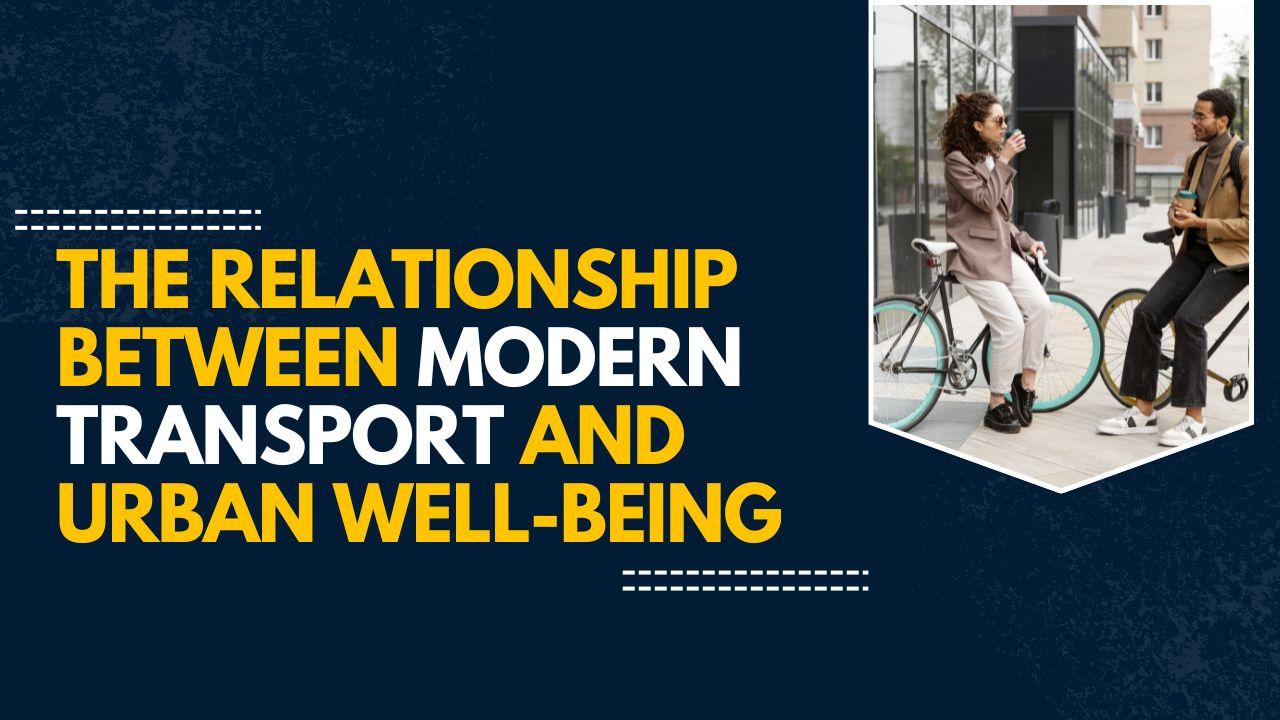The Relationship Between Modern Transport and Urban Well-Being

Modern transportation plays a major role in shaping how people live, work, and interact in cities. The way people move each day affects stress levels, health, productivity, and even the social balance of urban communities.
As cities grow and become more crowded, the need for better transport systems becomes stronger. Urban well-being is not only about comfort. It is about creating cities where people can move safely, easily, and without unnecessary pressure.
How Does Modern Transport Influence Daily Living?
Travel on a day-to-day basis impacts nearly every aspect of someone's daily life. A quick, streamlined trip can improve a person's mood for the entire day. A long, drawn-out trip can diminish a person's energy resources before the day starts. Current transport not only affects the means in which humans travel, it affects the opportunity of traveling.
Accessing the transport is fundamental for individuals to get to schools, healthcare, workplaces, and basic services (e.g. grocery stores). When someone's access to any resource has not been reliable, an individual could arrive late, pay higher rates, or have lower opportunities regardless of the resource. Aside from accessibility, a good transportation system can improve comfort.
For example, air-conditioned buses, clean bus stops, buses that arrive according to schedule, and safe bus routes provide comfort while commuting.
When talking about transport, it is clear that there is a connection to safety. If roadways are well maintained, signage is understood, and driver staff is trained, it is less likely that an accident will happen. In many modern cities, transport is made safer through improved traffic management systems which lets organizations monitor the flow of traffic in real time to reduce accidents.
Each of these items will support safety during travel, and also allow the travel to be more of a peace of mind when transport was the selected option.
What Makes Transport a Key Factor in Urban Well-Being?
Urban well-being depends on more than buildings and infrastructure. It encompasses mental health, physical health, and happiness with life. Transportation is directly related to all three.
If you have a comfortable trip, then you're less stressed out. When you know that you will arrive on time, that's less stress. No delays, easy to understand the routes, and clear information all contribute to better mental health.
Transit also helps the air quality. Efficient public transit means less reliance on private cars for travelling. Efficient transit reduces pollution and noise levels. More air quality results in improved respiratory health. Less noise levels equate to easier times resting and better times concentrating.
Transit also affects connection to others. When you can move more freely through neighborhoods, the bond you have with the community improves. Families stay closer. Friends can meet without difficulty. Cities feel more accessible and open.
How Do Cities Use Transport Planning to Improve Quality of Life?
Transport systems are now a focus of cities around the world for the support of public well-being. Cities are investing in connected routes and multimodal systems that enable the switch from buses to trains, to bikes and walking, with little or no difficulty.
Integrated public transport networks allow for shorter wait times and predictable travel for users, in which transit modes function in concert and people do not have to spend as much time planning their trip around the next driving route or train schedule.
Integrated transport planning gives far more consideration to future active mobility infrastructure. Increasingly, cities are developing walking paths, cycling lanes, and safe pedestrian areas in order to decrease vehicular road traffic, promote public health, and improve the experience of moving within cities.
An active mobility consulting service has real-time data at its disposal. This information informs active mobility planning by identifying peak use times, route congestion areas, and common delays, leading to better decisions that support fast and safe travel for users.
What Challenges Still Affect Modern Transport Systems?
Despite advancements made, many cities still present challenges. Overcrowding continues to be a significant issue. During peak hours, buses and trains can be so full that it can be uncomfortable and delayed. Traffic congestion is another prevalent problem. As more individuals continue to move to cities, the roadways can struggle with increased flow, causing a longer travelling time and greater fuel consumption.
There is also inequity of access. Some neighborhoods do not have the same level of service that other neighborhoods might have. Limited transport options have consequences on job access, education, and social opportunities.
Maintenance issues are a challenge as well. Poorly maintained roads or outdated vehicles contribute to slower speeds and unsafe traveling. Cities need to invest consistently to keep the transport systems functioning and operating effectively.
How Can Smarter Mobility Strengthen Urban Well-Being?
Smarter mobility solutions offer practical ways to improve movement and well-being at the same time. These solutions focus on efficiency, safety, and sustainability.
Cities are now increasing the number of pedestrian zones. These spaces help reduce car use, improve safety, and create cleaner air. They also encourage walking, which supports physical fitness.
Real-time transit apps allow people to track schedules and choose better routes. This reduces uncertainty. It also saves time and helps people feel more in control of their day.
Electric buses and low-emission vehicles help lower pollution. Cleaner transport benefits everyone in the city. It also supports long-term environmental goals.
Innovative solutions in planning and analytics are improving traffic flow. These tools help authorities adjust signals, manage congestion, and plan better road use.
Why Is Community Feedback Important in Transport Planning?
Transportation systems function most effectively if they are in touch with the needs of their members. To this end, community feedback is incredibly important. Users of transportation systems, who travel daily, understand best what does and doesn't work.
When municipalities listen to community voices, the public planning for additional services is completed with greater accuracy. Community feedback can indicate unsafe crossings, long wait times for services, or poor connections. These observations are valuable to the planning process, and will assist in fixing problems faster.
Community engagement also helps with accountability. When people advocate for feedback, and then see their feedback represented in new routes, changes and upgrades, they are committed. They will be more likely to support these initiatives later. This sense of ownership promotes long-term engagement.
Transportation planning also benefits from diverse perspectives. Different groups will have different needs. Students, seniors, workers, and families will all experience the city in different ways. Acknowledging these different groups will enhance the competency of the system.
Conclusion
Modern transport defines daily life in cities. It impacts comfort, safety, health, and social connection. Whenever transport is efficient and effective, cities are successful places. People have less stress, breathe cleaner air, and have greater access to daily needs.
Despite the successes, challenges remain. Congestion and limited access, as well as congestion and overcrowding, continue to impact many neighbourhoods. However, new methods of planning and new technologies are influencing better forms of urban transport.
Understanding urban well-being relies on movement that is reliable and efficient. As the cities continue to develop, mobile transport will become more and more critical. Establishing safe, clean and connected systems will result in healthier and happier communities. Transport is more than a system, it is an integral base of a strong and reasoned urban life.

- Creative Multimedia
- Education & Innovation
- Business & Technology
- Sustainability & Ethics
- App & IT Development
- Community & Culture
- Thought Leadership
- Event
- AI & Robotics
- Craft
- Movie
- Fitness
- Free Peck
- Game
- Tutorial
- Health
- Music
- Networking
- Other
- Business
- Religion
- Shop
- Sport
- Wellbeing



